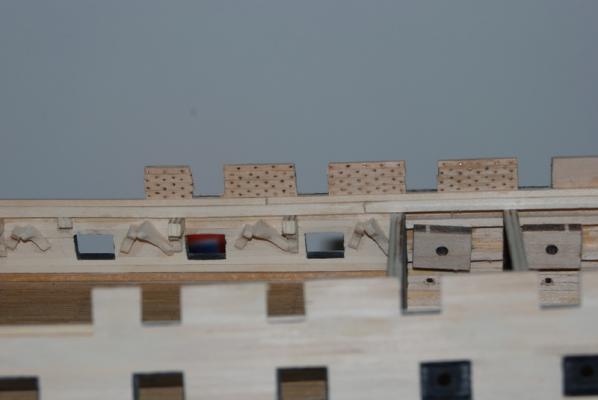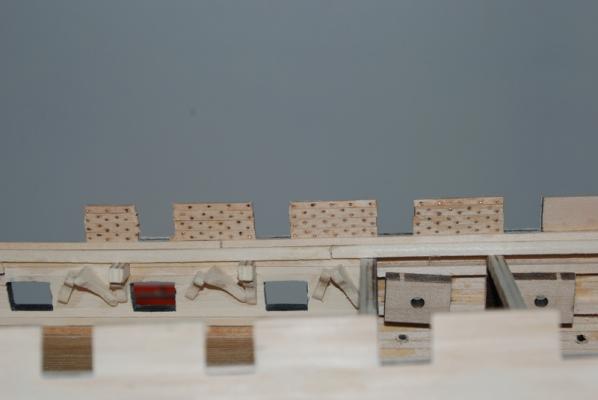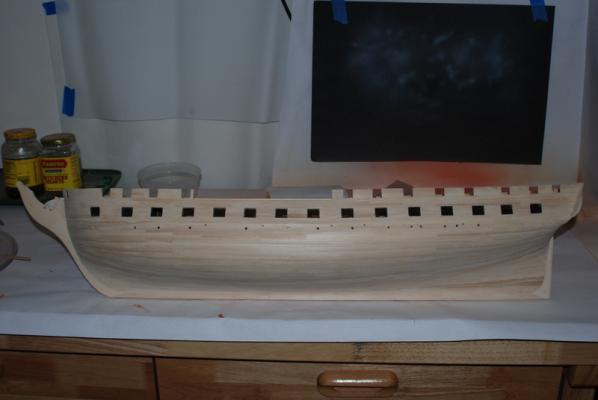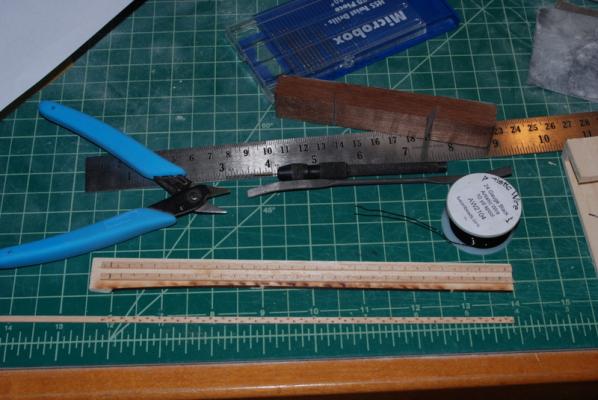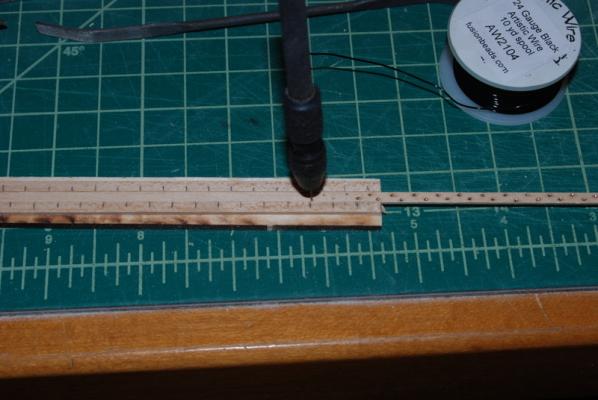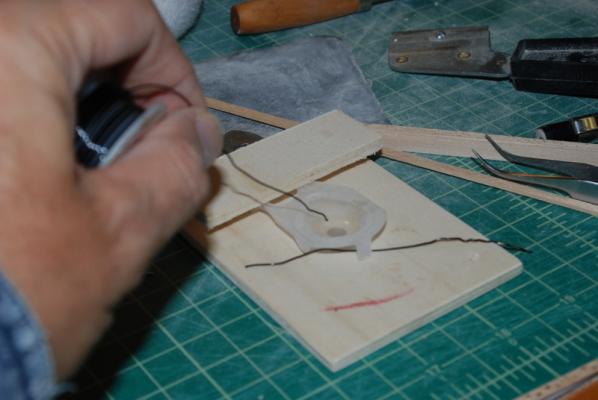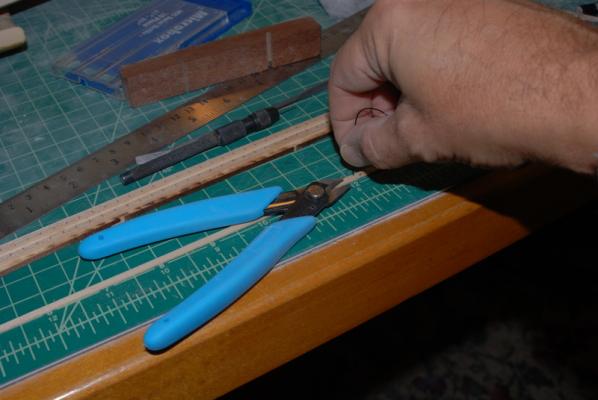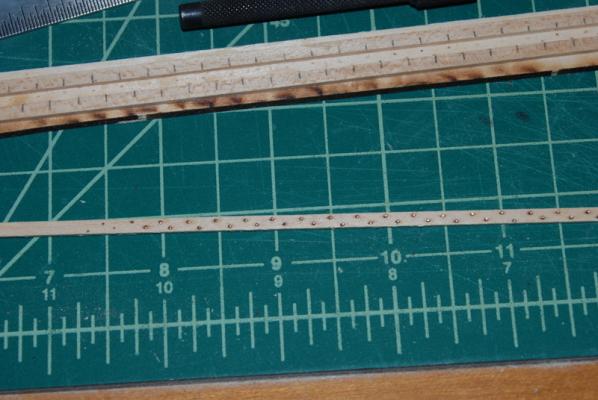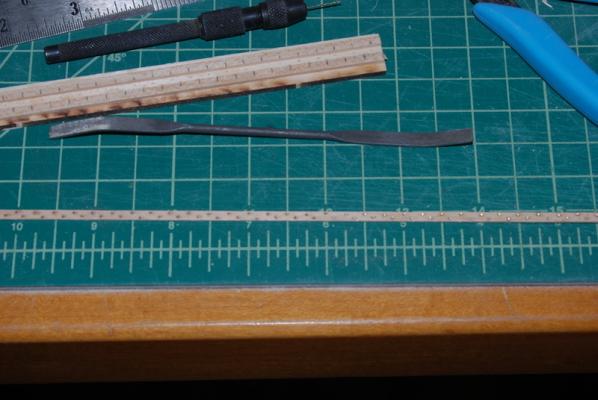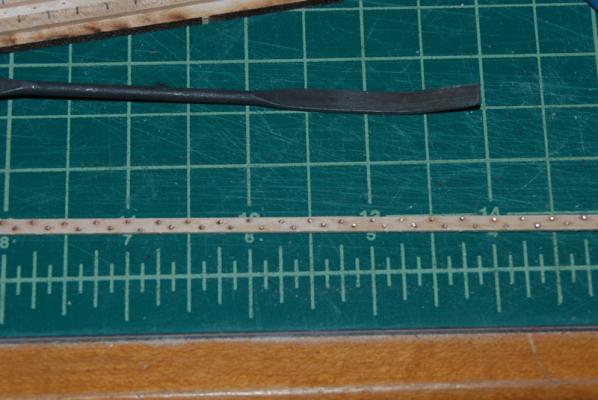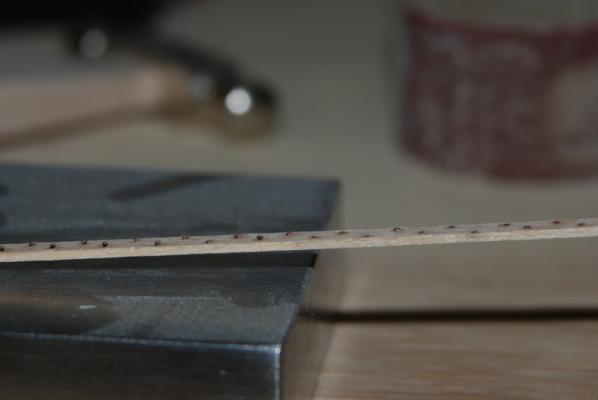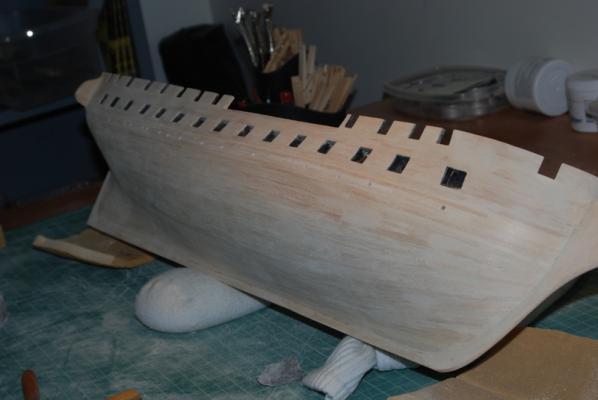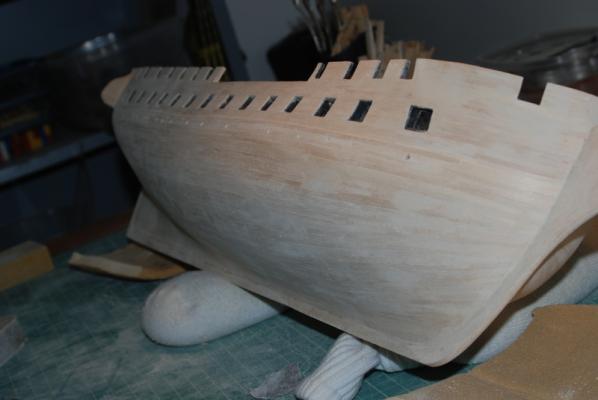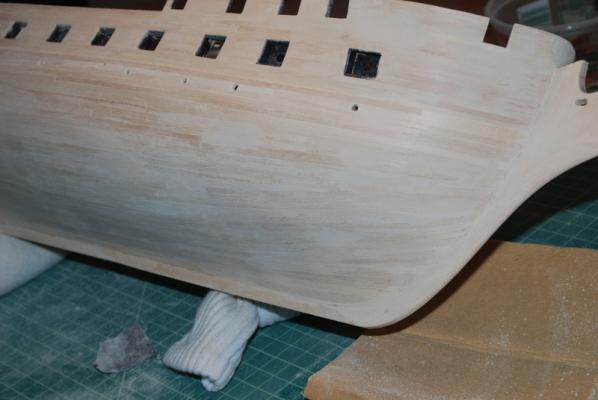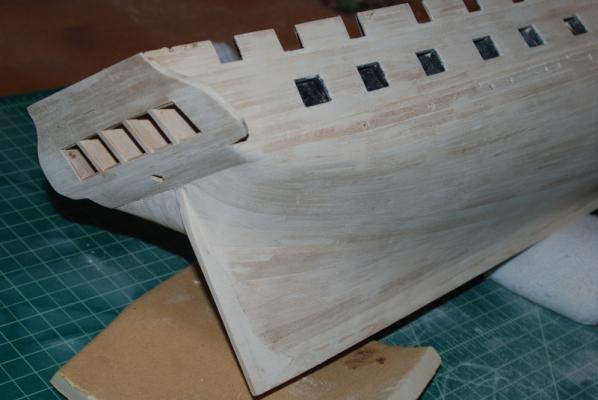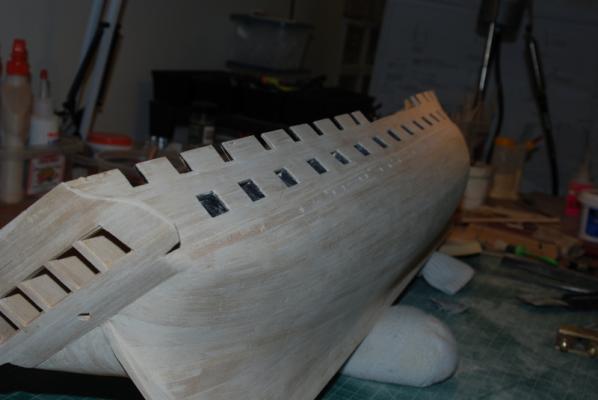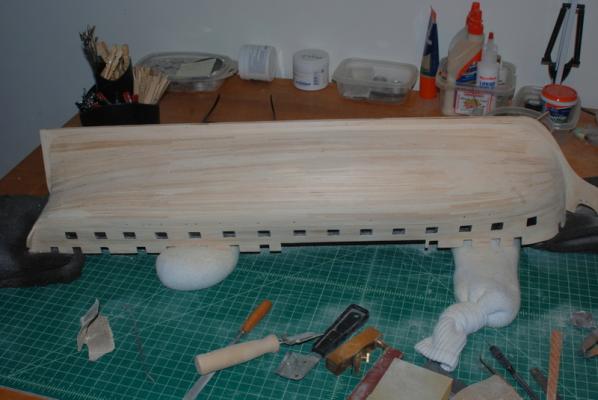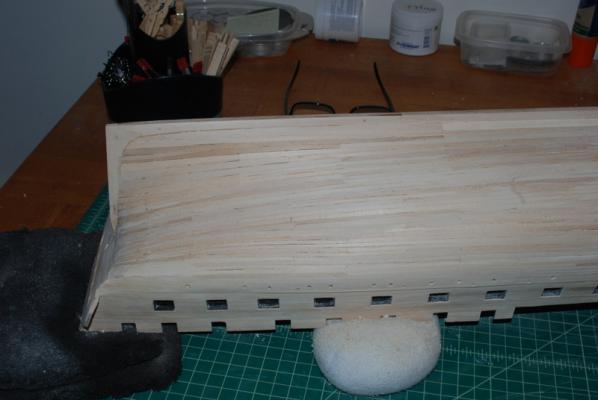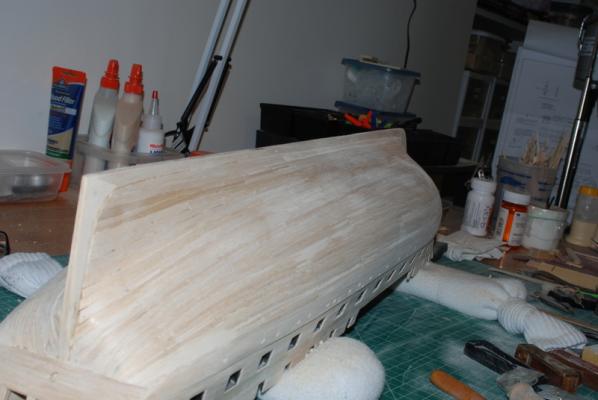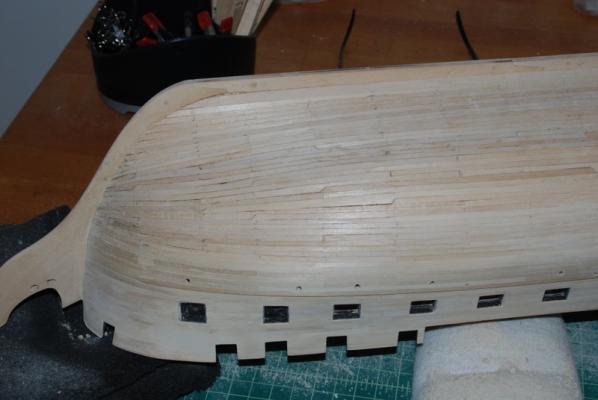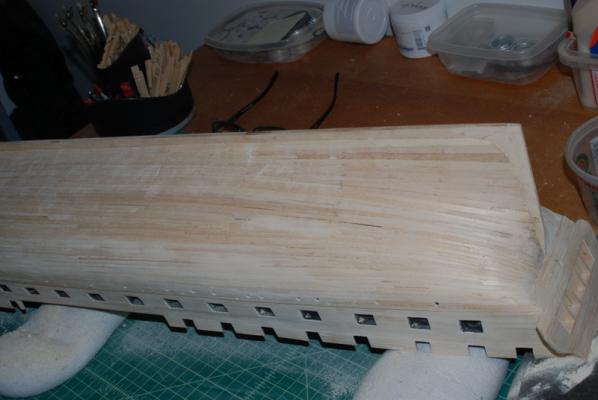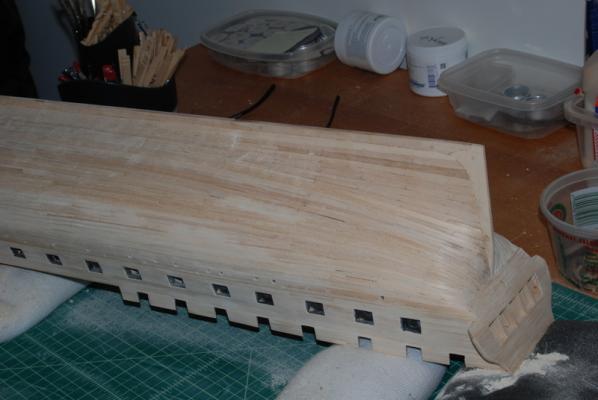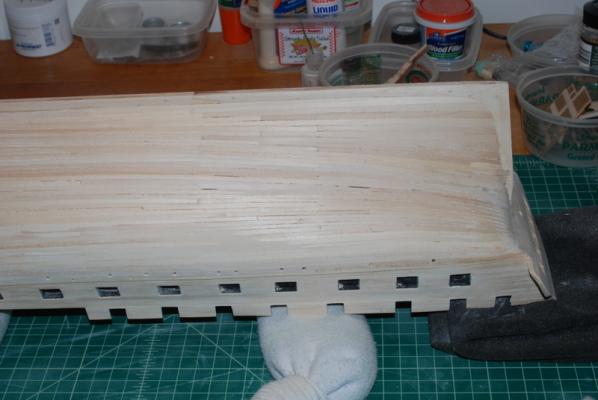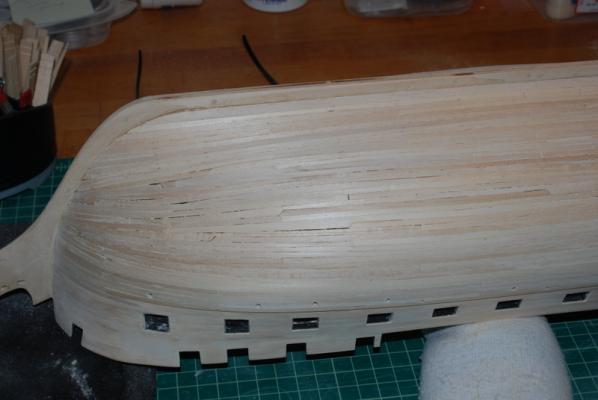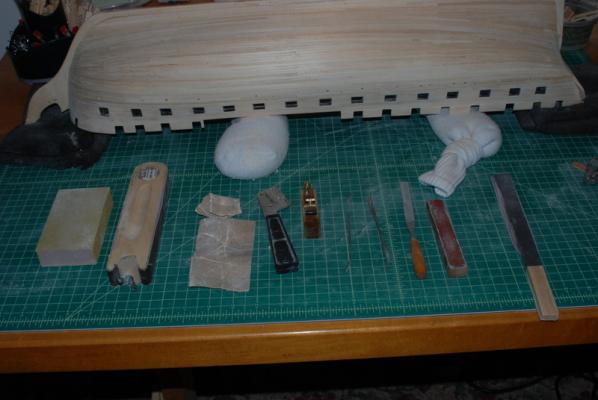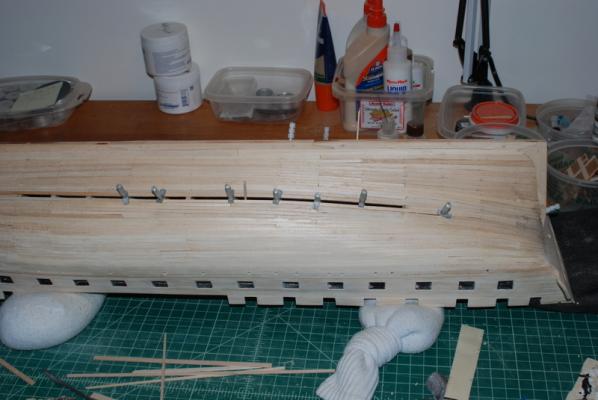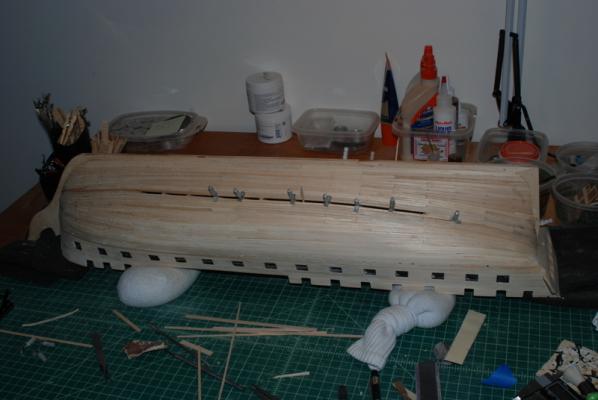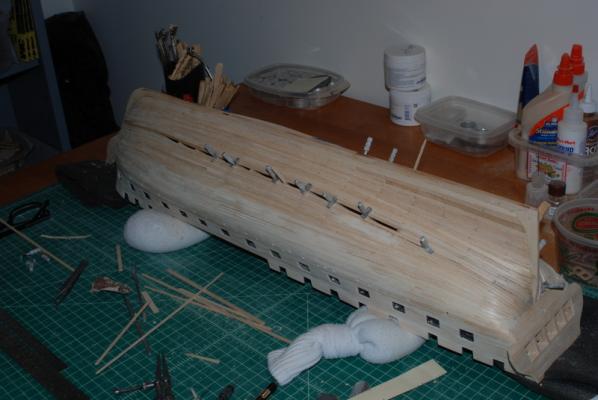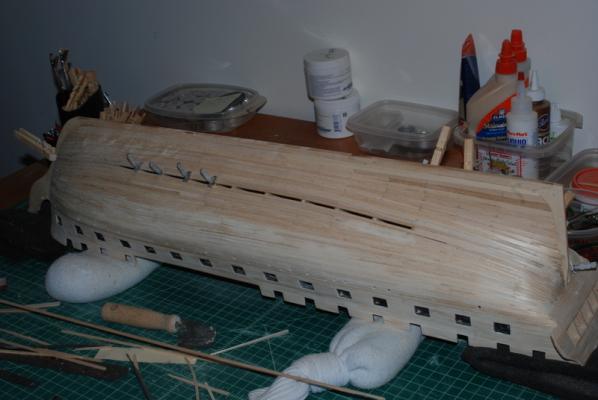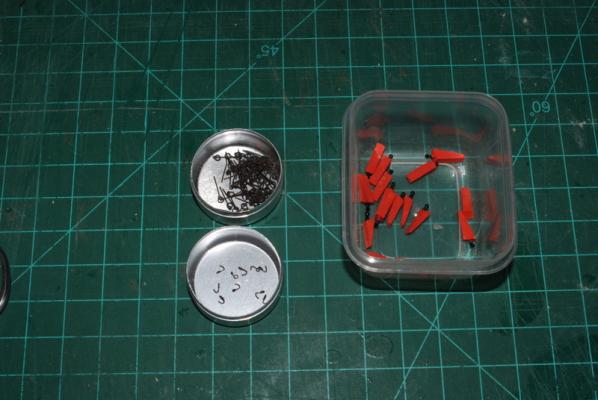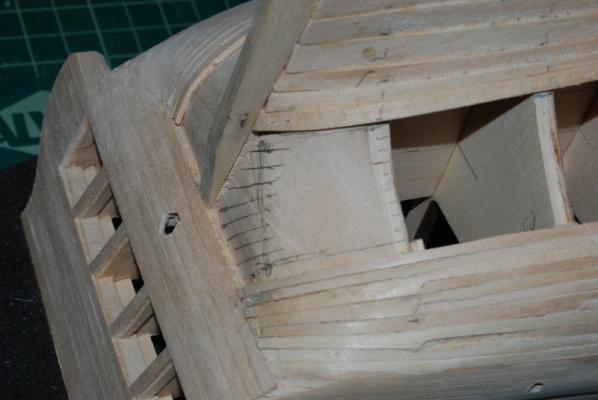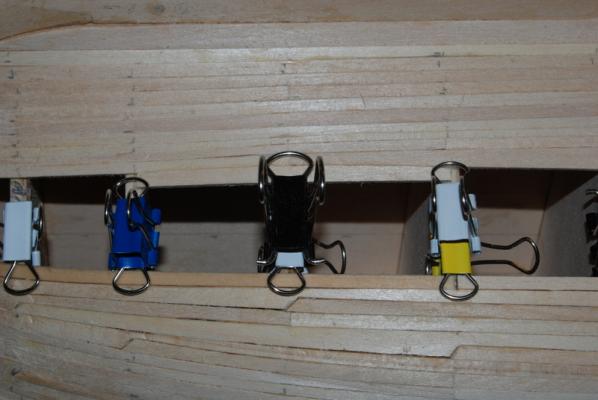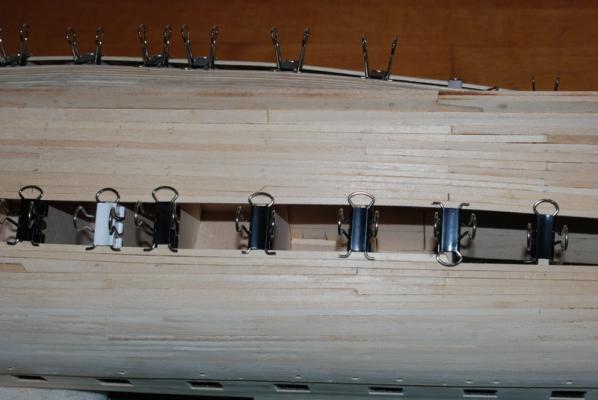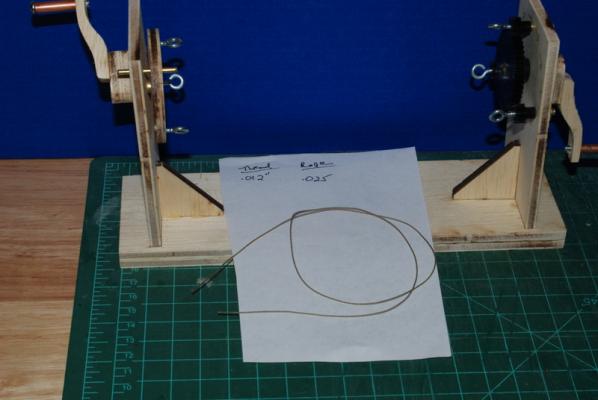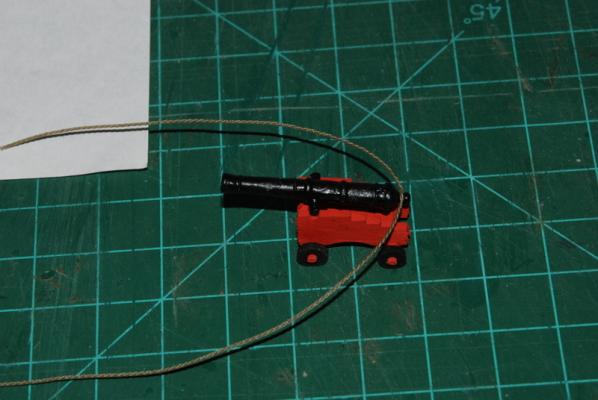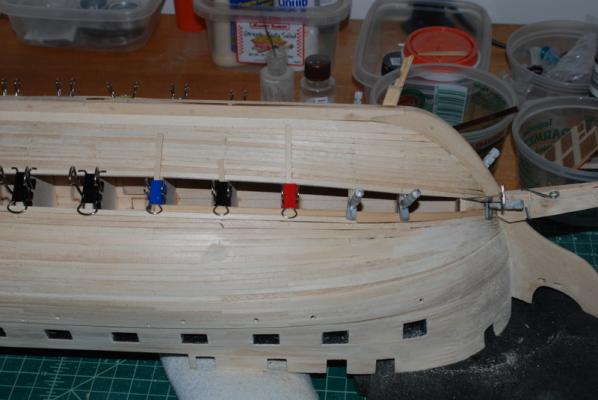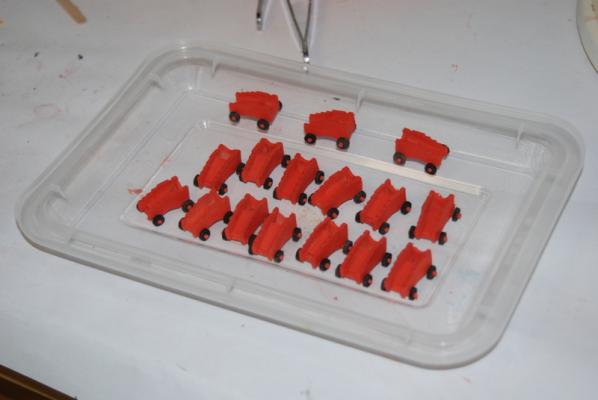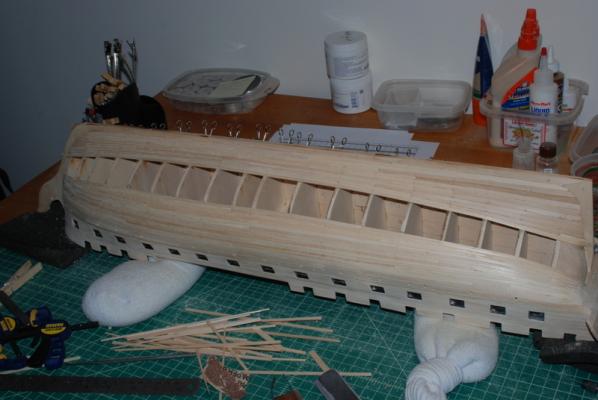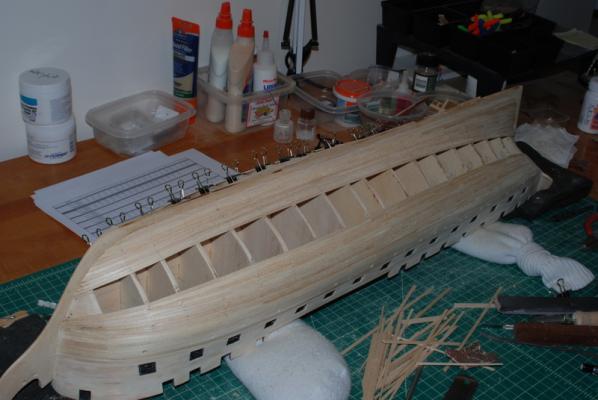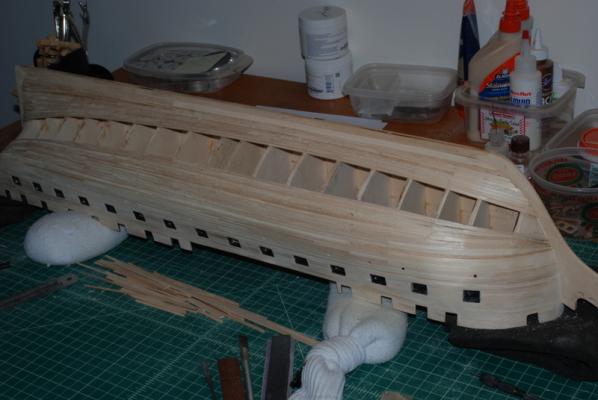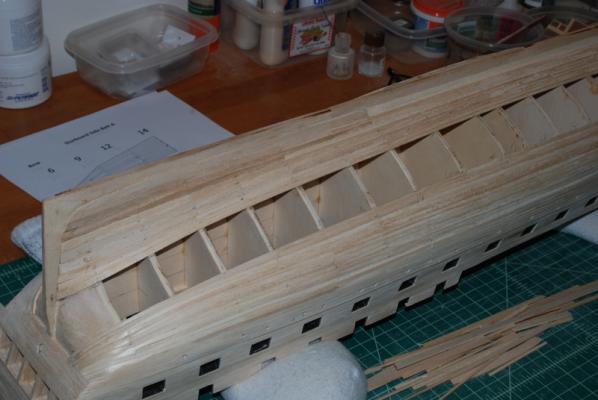-
Posts
2,409 -
Joined
-
Last visited
Content Type
Profiles
Forums
Gallery
Events
Everything posted by usedtosail
-
Well, here are the results. I planked a few sections of the inner bulwarks with the riveted planks. I still need to trim the ends to be flush with the gun ports. Not as precise as I have seen other modellers create these rivets, but I think the overall effect is what I was after. It will be a while before they are painted, so I am curious to see what they will look like then.
- 1,350 replies
-
- constitution
- model shipways
-
(and 1 more)
Tagged with:
-
Thanks all. After a fine Thanksgiving break I am back to work. I am excited to have the hull planking finished, at least for now. I did some more work on the wales to get them as smooth as the rest of the hull, so here it is after a medium and fine sanding of the whole hull. Scott - I hope I didn't make it too smooth. I know when I prime it, I will find that I have more blemishes to fill and sand out. Now it is on to more interesting work. Planking the inside bulwarks is the next task, with all those rivets to show. My original thought was to try using small drops of CA glue to simulate the rivets, like I have done on pintels and gudgeons in the past. This works fine on metal, but on wood the CA just soaked into the wood. OK, I thought, how about if I put some wipe on poly on the wood first. This slowed the soaking down, but eventually I had the same result. Time to come up with a new method. I had seen other builds where they bought individual rivets from a model railroad company, but when I priced these out they seemed a bit expensive. So, I came up with my own way to make rivets. I drilled some holes in a strip of wood, dipped the end of a wire into CA, then pushed it into the hole. I cut the wire off and repeated in the next hole. The wire was sticking up a bit, so I trimmed it flusher to the wood, then used a ball peen hammer to gently tap the ends down, which also mushroomed the wire just enough. I was happy with the look and the process wasn't too bad, so I made up a jig to help. Here is the story in pictures: First, here are the tools I used for this. That cutter does a good job but does not cut the wire completely flush, which worked out to be a good thing. You can see the jig I made up, which is just two strips of wood with offset markings to show where to drill the holes for the rivets. I am drilling two rows per strip, offset by half the distance between rivets, which is the pattern on the current ship. I am not yet sure if I can fit two rivets at the end of each strip, but I may try that. Most of the strips go between the gun ports, so they will be short. Here I have a planking strip in the jig and am drilling the holes. On my first attempt, I glued the wire into the holes with the strip still on the jig, but when I pulled the strip off a few of the wires stayed glued into the jig. I now drill the holes then take the strip out of the jig before gluing in the wires. I dip the end of the wire in a small puddle of medium CA. You can see my patented CA glue holder using small cups from my daughters contact lenses. I have a lifetime supply of these. Then I push the wire into a hole and cut it off with the cutters. I can get into a pretty good rhythm this way. After I fill a bunch of holes, I go back and trim the wires again to get them closer to the wood and here is how they look at this stage. I then use the file shown to gently file them down a little bit more and brighten the ends. At first I was going to use them like this, but after sleeping on it, I decided they were too sharp and still too high, so the next day I found this ball peen hammer and tried tapping them to see if they would flatten out a bit. I used this jewelers block that I had to keep the wires from pushing through the back of the strip. And here you can see the final result on the right, the wires on the left have not been tapped down yet. I was a bit worried that the tapping would flatten the wood out too much, but you can see from the side that the wood is still in pretty good shape. I will cut out a few strips and see how they look on the bulwarks tonight, but I think they will look good. Its a bit of work but not too bad, relative to all the other work that still needs to be done. This is such a prominent detail that I don't mind taking the time to make these strips. I don't yet know how to handle the curved planks at the bow. I think I will have to bend them to shape before adding the rivets, then add the rivets before gluing them to the bow. I think trying to bend the plank with all those holes would just break it. I am also in the process of designing a cradle for the model but that is a story for another day. I did measure the contour of the hull in the two places that the cradle will support, since this seemed like a good time for that before I start coppering the hull.
- 1,350 replies
-
- constitution
- model shipways
-
(and 1 more)
Tagged with:
-
I had to add wood on the insides of some of the bulwark extensions to fix these errors. I checked each of the bulkheads for symmetry before I added them to the keel and marked the areas that needed to be removed/added to. My bulwark extensions are not as high as the kit plans, however, since I am only building to the top of the main rail, since that is closer to the 1812 version.
-
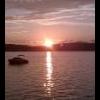
Cutty Sark by NenadM
usedtosail replied to NenadM's topic in - Build logs for subjects built 1851 - 1900
Really nice work, Nenad. Thanks for the tutorial.- 4,152 replies
-
- cutty sark
- tehnodidakta
-
(and 1 more)
Tagged with:
-
I just spent two days reading through your log Jon. You are doing fantastically for your first time build. I have learned a few things from the way you have approached some of the more challenging aspects of the build. I look forward to following along with the rest of it.
- 974 replies
-
- rattlesnake
- mamoli
-
(and 1 more)
Tagged with:
-
Thanks Tim, George, Scott, and Warren, and the likes. Scott - thanks for that reminder to not sand too much. I have had this problem in the past, especially where I had bad clinkering going on. I think filling the low spots with wood filler helps in this regard, as I can see how much is coming off as I sand it out, without trying to remove all the surrounding wood. I spent a couple of hours last night getting the rough sanding done. I had a ridge along both sides where the hull planking met the bottom of the wales, but after some serious attention with the sanding block I was able to get this area to flow together. Here are some shots of the hull at this point, ready for the medium and fine sanding, which will have to wait until Sunday, after the holiday. Happy Thanksgiving to all of you who celebrate it, and a nice weekend to the rest of you. PS - after looking at the pictures in the preview pane, I think there may be a few spots that still need some filler, which I will address as I do the rest of the sanding.
- 1,350 replies
-
- constitution
- model shipways
-
(and 1 more)
Tagged with:
-
Thanks again guys. The encouragement is really appreciated. Well, after 11 months of working on the hull, a major milestone has been reached - all of the outer hull planking is on. I spent this weekend sanding and scraping the hull, adding wood filler where needed, and sanding and scraping some more. I am still only using rough sand paper, so there is still a lot of work to be done. Here is a picture of the various tools I am using to get the planks smoothed down. The curved end of the large sanding block has really come in handy on the curved parts of the hull, especially in the stern. The handle with the straight razor blade I use as a scraper. That little block plane come in handy with planks that are raised from the rest. Here are some shots of the rough planking before I started sanding: And here are some shots during the sanding process: These two shots are after some sanding but before any wood filler was added. You can see some of the gaps that have to be filled. I am not sure how long it is going to take me to get to the point where I can start sanding with finer paper, but probably later this week. It always amazes me how much better this looks after some wood filler and a preliminary sanding. But, then it seems to take just as long or longer to get to a finished hull, if there is such a thing. As I said before, I always find areas that could use more work and I don't expect this hull to be any different.
- 1,350 replies
-
- constitution
- model shipways
-
(and 1 more)
Tagged with:
-
Thanks again guys for the encouragement. I am feeling a bit better about the state of the planking now that it is almost done. I am down to one plank section per side, which I should be able to finish up tonight. Those screw in planking clamps have worked really well on these small gaps. I bought a bunch of them a few years ago when Micro Mark had them on sale, so I didn't run out once on this build. They were a bit expensive even on sale, but they sure came in handy. There were even a few planks where I did not have a gap left that I just screwed the post through the plank to hold it, which I will fill the hole with putty now. I first tried straight pins, but they would not hold the planks flat to the filler blocks. I am seeing some wavy-ness when looking down the hull, but I think that will be sanded out when I complete the sanding. That is going to be the next big task, one in which I always have a hard time. I think that I am getting close to being done, then look at the hull with light from a different angle and see all sorts of anomalies. And this hull is bigger by a lot than any previous planking that I have done. So, I just need to get at it and take my time and be generous with the wood putty (although most of it will get sanded off). Since I am down to working one plank per side at a time, I have had some time to make all the quoins for the gun deck cannons. I also made all the ring bolts for them, which I have blackened along with the eye bolts for them. I have started making the hooks for the gun tackles, as well. I can do about 10 per night before my eyes give out, and I need about 90 of them. I started out trying to use a pair of pliers with round ends for the loops, but ended up using tweezers instead, which resulted in smaller loops. The hook part is made by bending around the end of a needle nose pliers. I do this all with the wire still on the roll, then cut off the hook and file the end somewhat pointy, although not as pointy as I would like yet. It is really hard to hold them still while filing, since they are so small. I will post pictures of the sanding as it progresses.
- 1,350 replies
-
- constitution
- model shipways
-
(and 1 more)
Tagged with:
-
Very nice Bob. Those sails really do her justice. You and the admiral both must be very happy.
- 420 replies
-
Yes the pumps were replaced. Here is some text from the Constitution CD: 1812 Pumps = “Chain” pumps (right) - pulled water up from the hold. Mid-1800s = copper pumps found on gun deck today (left, below). Hand-operated fresh water pump, berth deck, c.1870s (below, center). There were also „fire engines‟ with hand pumps on board that used sea water to put out deck or fires in the rigging.
- 113 replies
-
- constitution
- mamoli
-
(and 1 more)
Tagged with:
-
Thanks Steve. I have to confess that the lower resolution of the photos shows the planking a bit better than in real life. For a hull that is going to be painted and coppered, it will be fine. For one that would show the natural wood, it would not do. But please use it as a guide and I am sure yours will be great.
- 1,350 replies
-
- constitution
- model shipways
-
(and 1 more)
Tagged with:
-
Carl - I think you will enjoy this kit. I will definitely follow along if you do a build log. Thanks Tim - I feel like my planking is such a hack job compared to your planking work, as on the Sultana. Thanks George. I know the answer to that one already - she would sink like a stone with all the planking gaps I have. I have already started to fill them with some wood filler in anticipation of the hull sanding. I have a dilemma concerning the breech ropes. It turns out these should be 6 1/2" circumference, not diameter, so the ropes I made are too thick. The dilemma I have is that a 6 1/2" circumference rope would be about 2" diameter, which is about the size of one of the three strand in that rope. This would look way too small in my opinion, although in real life it makes sense as a 6" diameter line would be very big. So, the question is should I go with an accurate size even if it looks too small or go with something that looks better to me? I am sure I am not the first person to have this dilemma so any advice would be greatly appreciated. Thanks.
- 1,350 replies
-
- constitution
- model shipways
-
(and 1 more)
Tagged with:
-
Thanks Markku. Your Constitution build is coming along very nicely. It was nice to get some quality time in the basement this weekend between raking leaves.
- 1,350 replies
-
- constitution
- model shipways
-
(and 1 more)
Tagged with:
-
Thanks for the likes, guys. Planking continues and is getting closer to being finished. I marked off the ends of the planks in belt B on the transom filler block, because it was the only way I could figure out what the widths should be here. I first marked off the plank widths on the last bulkhead, then drew a line across the gap closer to the keel and divided it by the same number of planks. I then drew lines between the two marks and extended them all the way to the keel to get the shapes and widths at the keel: I found that if I fold the handles down on the binder clips, I can piggy back them to do two planks at once: Here is the sweet spot - one clamp holds two planks at once: The gap is getting pretty small, so other clamping methods need to be employed: This weekend I also finished assembling the ME rope walk I bought in their the 40% off sale. I always wanted to try rope making and this was a low cost way to do that. I twisted up three strands of 0.012" diameter nylon thread and its produced a very nice rope, which is 0.025" diameter. This just happens to correspond to 6 1/2" real world diameter at the Connie scale, so it is the perfect size for the cannon breech lines. I can untwist the rope slightly and fit it over the cassabel on the end of the cannon, instead of wrapping the whole rope around the casabel: I also gave the cannon carriages a dry rub of raw sienna paint, which toned down the red a bit. As always, thanks for looking in and please let me know if I can improve on any of these ideas. I really appreciate any advice or criticism.
- 1,350 replies
-
- constitution
- model shipways
-
(and 1 more)
Tagged with:
-
Here is another belaying pin plan for the Constitution that I found, but I forget where: Belaying Plan.pdf
- 335 replies
-
- Constitution
- Mamoli
-
(and 3 more)
Tagged with:
-
I have finished planking belts A and C, and have taken the measurements of the gaps in belt B. Before taking these pictures, I gave the planks a preliminary sanding, mostly to take down the high spots and fill in some of the larger gaps with saw dust . Starboard side: Port side: A few thoughts on the planking so far. Some of the things I like about it: No major clinkering of the planks. These planks are pretty narrow, so they edge bent easily. I did not have to spile these to get them to curve around the bow. When I planked the Beagle, I had some planks sanded so thin to remove the clikering, I thought I would go all the way through them. Not too many gaps between planks. I was able to get a pretty good fit with the basswood since they were easy to sand. Some of the things I don't like / would do differently: The wales came too far down in the bow. I should have reduced the width of these planks more in the bow so that the gap would have been wider for belt A. I had to add a lot of drop planks to get these to fit. Some slight clinkering between planks - I am pretty sure this is due to the glue build up of the previous plank, leaving the next plank raised slightly at the join. I will try to eliminate this in belt B by sanding down the bulkheads next to the previous plank before adding the next plank. In any case, this was pretty easy to sand off. The thickness of the planks was a bit inconsistent, so I have some planks that are a bit below their neighbors. This requires the neighbors to be sanded down a lot, but I am able to use wood filler to fill these voids and avoid some of the sanding. Thankfully, the hull will be painted and coppered. The width of the planks was just a little wider than shown on the plans, so I was not able to use the planking plan from the plans. The plans show no dropped planks, so I should have paid more attention to it. If I had run all the planking through a sanding drum to get them a little narrower I may have been able to use the plans. I should have added some of the drop planks more toward the center of the hull, not just on the ends. This would have left the planks a bit wider toward the ends and reduced the number of drop planks. I am going to do this on belt B, so it will be interesting to see the difference. Toward the end of belts A and C, I started marking the actual plank widths on the bulkheads, so I could see much better where the drop planks should go. I will also be doing this in belt B. I should have added filler blocks between bulkheads B and C. The planks wanted to flatten between these bulkheads instead of curving nicely. I also continue to work on the gun deck gun carriages. Here they are painted with the painted trucks in place. In most of these, the trucks are just pressed on. I will be adding the eyebolts and rings for the tackles and breech ropes next. I will be glad when this planking is over, but I am enjoying it so far.
- 1,350 replies
-
- constitution
- model shipways
-
(and 1 more)
Tagged with:
-
Thanks everyone. Scott - when those binder clips no longer fit, I will use small drops of CA to hold the planks along with pins pushed through holes drilled through the planks. I have already started to use pins on the extreme ends of the planks over the filler blocks.
- 1,350 replies
-
- constitution
- model shipways
-
(and 1 more)
Tagged with:
-
Use code OC8 at Model Expo and you can get it for $299, although it is on backorder at the moment. This is one of the cheapest prices I have seen for it.
-
I am attempting to build the MS kit in an 1812 configuration. The link to my build log is below. Also, check out this build log, which is plastic but has a lot of information on the 1812 configuration: http://modelshipworld.com/index.php/topic/270-uss-constitution-by-force9-revell-plastic-revisiting-the-classic-196-kit/#entry2211 TimI and Mundie are also building the MS kit in the 1812 configuration.
-
Really nice tool box and oars, Steve. I used tan lines for the oars, but since yours will be weathered, I'd go with a dark brown.
- 625 replies
-
- bounty launch
- model shipways
-
(and 1 more)
Tagged with:
-
Thanks Tim and George. Those are the medium size binder clips. I have already needed to start using the small binder clips in some places now.
- 1,350 replies
-
- constitution
- model shipways
-
(and 1 more)
Tagged with:
About us
Modelshipworld - Advancing Ship Modeling through Research
SSL Secured
Your security is important for us so this Website is SSL-Secured
NRG Mailing Address
Nautical Research Guild
237 South Lincoln Street
Westmont IL, 60559-1917
Model Ship World ® and the MSW logo are Registered Trademarks, and belong to the Nautical Research Guild (United States Patent and Trademark Office: No. 6,929,264 & No. 6,929,274, registered Dec. 20, 2022)
Helpful Links
About the NRG
If you enjoy building ship models that are historically accurate as well as beautiful, then The Nautical Research Guild (NRG) is just right for you.
The Guild is a non-profit educational organization whose mission is to “Advance Ship Modeling Through Research”. We provide support to our members in their efforts to raise the quality of their model ships.
The Nautical Research Guild has published our world-renowned quarterly magazine, The Nautical Research Journal, since 1955. The pages of the Journal are full of articles by accomplished ship modelers who show you how they create those exquisite details on their models, and by maritime historians who show you the correct details to build. The Journal is available in both print and digital editions. Go to the NRG web site (www.thenrg.org) to download a complimentary digital copy of the Journal. The NRG also publishes plan sets, books and compilations of back issues of the Journal and the former Ships in Scale and Model Ship Builder magazines.


